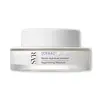What's inside
What's inside
 Key Ingredients
Key Ingredients

 Benefits
Benefits

 Concerns
Concerns

 Ingredients Side-by-side
Ingredients Side-by-side

Water
Skin ConditioningButylene Glycol
HumectantCaprylic/Capric Triglyceride
MaskingCoco-Caprylate/Caprate
EmollientOrbignya Oleifera Seed Oil
EmollientGlycol Palmitate
EmulsifyingBehenyl Alcohol
EmollientAscorbyl Tetraisopalmitate
AntioxidantArachidyl Alcohol
Emollient1,2-Hexanediol
Skin ConditioningArachidyl Glucoside
EmulsifyingAcrylates/C10-30 Alkyl Acrylate Crosspolymer
Emulsion StabilisingMaltodextrin
AbsorbentParfum
MaskingCaprylyl Glycol
EmollientXanthan Gum
EmulsifyingCeramide NP
Skin ConditioningLactobacillus Ferment
Skin ConditioningPentaerythrityl Tetra-Di-T-Butyl Hydroxyhydrocinnamate
AntioxidantSodium Acetylated Hyaluronate
HumectantSodium Hydroxide
BufferingWater, Butylene Glycol, Caprylic/Capric Triglyceride, Coco-Caprylate/Caprate, Orbignya Oleifera Seed Oil, Glycol Palmitate, Behenyl Alcohol, Ascorbyl Tetraisopalmitate, Arachidyl Alcohol, 1,2-Hexanediol, Arachidyl Glucoside, Acrylates/C10-30 Alkyl Acrylate Crosspolymer, Maltodextrin, Parfum, Caprylyl Glycol, Xanthan Gum, Ceramide NP, Lactobacillus Ferment, Pentaerythrityl Tetra-Di-T-Butyl Hydroxyhydrocinnamate, Sodium Acetylated Hyaluronate, Sodium Hydroxide
Water
Skin ConditioningGlycerin
HumectantMethyl Methacrylate Crosspolymer
Dipropylene Glycol
HumectantZinc Gluconate
Skin ConditioningCoco-Caprylate/Caprate
EmollientVinyl Dimethicone/Methicone Silsesquioxane Crosspolymer
Caprylic/Capric Triglyceride
MaskingArachidyl Alcohol
EmollientBehenyl Alcohol
EmollientPolyacrylate Crosspolymer-6
Emulsion StabilisingSodium Polyacrylate
AbsorbentGlycyrrhetinic Acid
Skin ConditioningPropylene Glycol
HumectantArachidyl Glucoside
EmulsifyingBakuchiol
AntimicrobialLaminaria Ochroleuca Extract
Skin ConditioningMannitol
HumectantXylitol
HumectantSodium Metabisulfite
AntioxidantRhamnose
HumectantGinkgo Biloba Leaf Extract
Skin ConditioningTocopherol
AntioxidantFructooligosaccharides
HumectantParfum
MaskingWater, Glycerin, Methyl Methacrylate Crosspolymer, Dipropylene Glycol, Zinc Gluconate, Coco-Caprylate/Caprate, Vinyl Dimethicone/Methicone Silsesquioxane Crosspolymer, Caprylic/Capric Triglyceride, Arachidyl Alcohol, Behenyl Alcohol, Polyacrylate Crosspolymer-6, Sodium Polyacrylate, Glycyrrhetinic Acid, Propylene Glycol, Arachidyl Glucoside, Bakuchiol, Laminaria Ochroleuca Extract, Mannitol, Xylitol, Sodium Metabisulfite, Rhamnose, Ginkgo Biloba Leaf Extract, Tocopherol, Fructooligosaccharides, Parfum
 Reviews
Reviews

Alternatives
Ingredients Explained
These ingredients are found in both products.
Ingredients higher up in an ingredient list are typically present in a larger amount.
Arachidyl Alcohol is a fatty alcohol made from peanut oil. It is an emollient, emulsifier, and thickener.
You'll most likely find this ingredient as an emulsifier in water-based cosmetics.
We don't have a description for Arachidyl Glucoside yet.
Behenyl Alcohol is a type of fatty alcohol (these are different from the drying, solvent alcohols).
Fatty Alcohols have hydrating properties and are most often used as an emollient or to thicken a product. They are usually derived from natural fats and oils; behenyl alcohol is derived from the fats of vegetable oils.
Emollients help keep your skin soft and hydrated by creating a film that traps moisture in.
In 2000, Behenyl Alcohol was approved by the US as medicine to reduce the duration of cold sores.
Learn more about Behenyl AlcoholThis ingredient is an emollient, solvent, and texture enhancer. It is considered a skin-softener by helping the skin prevent moisture loss.
It helps thicken a product's formula and makes it easier to spread by dissolving clumping compounds.
Caprylic Triglyceride is made by combining glycerin with coconut oil, forming a clear liquid.
While there is an assumption Caprylic Triglyceride can clog pores due to it being derived from coconut oil, there is no research supporting this.
Learn more about Caprylic/Capric TriglycerideCoco-Caprylate/Caprate is created from fatty coconut alcohol, caprylic acid, and capric acid.
It is a lightweight emollient. Emollients create a thin barrier on the skin to trap moisture in. This helps keep your skin hydrated and soft.
Once applied, Coco-Caprylate/Caprate is absorbed quickly and leaves a silky feel.
Coco-Caprylate/Caprate may not be fungal acne safe.
Learn more about Coco-Caprylate/CaprateParfum is a catch-all term for an ingredient or more that is used to give a scent to products.
Also called "fragrance", this ingredient can be a blend of hundreds of chemicals or plant oils. This means every product with "fragrance" or "parfum" in the ingredients list is a different mixture.
For instance, Habanolide is a proprietary trade name for a specific aroma chemical. When used as a fragrance ingredient in cosmetics, most aroma chemicals fall under the broad labeling category of “FRAGRANCE” or “PARFUM” according to EU and US regulations.
The term 'parfum' or 'fragrance' is not regulated in many countries. In many cases, it is up to the brand to define this term.
For instance, many brands choose to label themselves as "fragrance-free" because they are not using synthetic fragrances. However, their products may still contain ingredients such as essential oils that are considered a fragrance by INCI standards.
One example is Calendula flower extract. Calendula is an essential oil that still imparts a scent or 'fragrance'.
Depending on the blend, the ingredients in the mixture can cause allergies and sensitivities on the skin. Some ingredients that are known EU allergens include linalool and citronellol.
Parfum can also be used to mask or cover an unpleasant scent.
The bottom line is: not all fragrances/parfum/ingredients are created equally. If you are worried about fragrances, we recommend taking a closer look at an ingredient. And of course, we always recommend speaking with a professional.
Learn more about ParfumWater. It's the most common cosmetic ingredient of all. You'll usually see it at the top of ingredient lists, meaning that it makes up the largest part of the product.
So why is it so popular? Water most often acts as a solvent - this means that it helps dissolve other ingredients into the formulation.
You'll also recognize water as that liquid we all need to stay alive. If you see this, drink a glass of water. Stay hydrated!
Learn more about Water